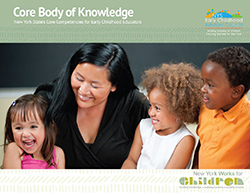
Core Body of Knowledge
New York State's Core Competencies for Early Childhood Educators

4.3
Resources for Competency 4.3:
2
click to view resource list
Addresses Challenging Behavior
The professional working with young children works to effectively and calmly address challenging behavior
Resources & Media for Understanding Competency 4.3
Behaviors & Skills
-
aConsiders whether or not his or her expectations of behavior are appropriate for the age and development of the child
-
bResponds to challenging behavior in ways that match the child's development
-
cUses a consistent process of reflection and action to address challenging behavior:
• Gathers information by asking him/herself: "What is going on?" "Where and in which situations does this behavior occur?" "What triggers this behavior?"
• Self-reflects: "Why is this happening?" "What can I change about my behavior?" "What can I change about the environment?"
• Considers various possibilities: "What might I try?" "When?" "How?"
• Assesses tried actions: "Did it work?" If not, "What next?"
-
dConsiders other experiences, life circumstances, and whether a child is trying to establish a sense of belonging by exhibiting challenging behavior (i.e., trying to get others to focus on them, hurting others or their things because they feel hurt, etc.) and chooses a response or solution that matches that need
-
eConsiders what he or she knows about individual children's temperament (i.e., activity level, adaptability, persistence) and responds to challenging behavior in ways that match the children's temperament
-
fRemains calm and respectful toward the child exhibiting challenging behavior
-
gAllows natural consequences to guide children's behavior as much as possible
-
hWhen appropriate, applies logical consequences that are related to the challenging behavior and its function, that are
respectful to the child, and that are reasonable
-
iIntervenes immediately to stop behavior that affects safety and/or ability to learn, including bullying or rejecting others
-
jMakes sure children understand the connection between behavior and consequence
-
kWhen a child uses negative behavior, discusses the behavior with the child in private and in the context of expectations based on respect
-
lTeaches children more effective ways to meet their wants and needs, making the challenging behavior unnecessary
-
mEncourages children to monitor their own behavior
-
nFor serious behavior challenges, seeks the assistance of an administrator, psychologist, or behavior specialist to help provide creative and effective interventions
-
oIdentifies and describes the challenging behavior as a preliminary step in using a Functional Behavioral Assessment (FBA)
-
pUses FBA to determine the "function" of a challenging behavior (the purpose a challenging behavior serves for the child)
-
qIdentifies what happens right before (antecedent) and what happens right after (consequence) challenging behavior occurs
-
rDevelops a behavior intervention plan
-
sRegularly evaluates behavior intervention plans to make appropriate modifications, accommodations and interventions as necessary


